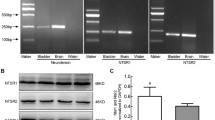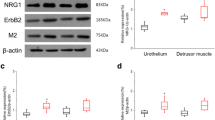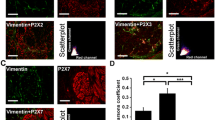Abstract
Introduction: Antimuscarinic drugs have frequently been used for the treatment for patients with an overactive bladder (OAB) and there have been many studies on the distribution of muscarinic receptor subtypes in the bladder. However, the distribution of muscarinic receptor subtypes in OAB patients has not been well investigated. In this study we investigated the distribution of muscarinic receptor subtypes with mRNA and protein expressions in patients with and without OAB, and investigated both the dome and trigone area.
Methods: Samples of bladder smooth muscle were obtained from 10 individuals, five patients with OAB and a non-OAB group consisting of five patients who received radical cystectomy.
Results: The M2 receptor was predominant, but there was no significant difference in the level of M2 expression between the groups in the dome area. M5 expression in the dome area was significantly higher in the OAB group than in the non-OAB group. In the trigone area, the level of M2 mRNA expression was the highest in the non-OAB group, and was significantly lower in the OAB group. The levels of M1 and M5 mRNA expression were also observed in samples obtained from the trigone area.
Conclusion: The multiformity of the muscarinic receptor subtypes in human bladder smooth muscle was confirmed, and our results suggest that the efficacy of a given pharmacologic therapy differs from patient to patient.



Similar content being viewed by others
References
Abrams P, Cardozo L, Fall M, et al. The standardization of terminology of lower urinary tract function: report from the Standardization Subcommittee of the International Continence Society. Neurourol Urodyn 2002; 21: 167–78
Milsom I, Abrams P, Cardozo L, et al. How widespread are the symptoms of an overactive bladder and how are they managed?: a population-based prevalence study. BJU Int 2001; 87: 760–6
Stewart WF, Corey R, Herzog AR, et al. Prevalence of overactive bladder in women: results from the Noble Program. Int Urogynecol J Pelvic Floor Dysfunct 2001; 12: S66
Wein AJ, Rovner ES. Definition and epidemiology of overactive bladder. Urology 2002 Nov; 60(5 Suppl. 1): 7–12
Fantl JA, Newman DK, Colling J, et al. Managing acute and chronic urinary incontinence: clinical practice guidelines: quick reference guide for clinicians, No. 2, 1996 Update. Rockville (MD): US Department of Health and Human Services, Public Health Service, Agency for Health Care Policy and Research; 1996. AHCPR Pub. No. 96-0686
Abrams P, Khoury S, Wein A. First International Consultation on Incontinence. Plymouth: Health Publications Ltd, 1999
Andersson KE. The pharmacology of lower urinary tract smooth muscles and penile erectile tissues. Pharmacol Rev 1993; 45: 253–308
Caulfield MP, Birdsall NJ. International Union of Pharmacology: XVII. Classification of muscarinic acetylcholine receptors. Pharmacol Rev 1998; 50: 279–90
Maeda A, Tubo T, Mishima M, et al. Tissue distribution of mRNAs encoding muscarinic acetylcholine receptor subtypes. FEBS Lett 1988; 239: 339–42
Kondo S, Morita T, Tashima Y. Muscarinic cholinergic receptor subtypes in human detrusor muscle studied by labeled and nonlabeled pirenzepine, AFDX-116 and 4DAMP. Urol Int 1995; 54: 150–3
Chess-Williams R, Chapple CR, Yamanishi T, et al. The minor population of M3-receptors mediate contraction of human detrusor muscle in vitro. J Auton Pharmacol 2002; 21: 243–8
Yamaguchi O, Shishido K, Tamura K, et al. Evaluation of mRNAs encoding muscarinic receptor subtypes in human detrusor muscle. J Urol 1996; 156: 1208–13
Braverman AS, Kohn IJ, Luthin GR, et al. Prejunctional M1 facilitatory and M2 inhibitory muscarinic receptors mediate rat urinary bladder contractility. Am J Physiol 1998; 274: 517–23
Hegde SS, Choppin A, Bonhaus D, et al. Functional role of M2 and M3 muscarinic receptors in the urinary bladder of rats in vitro and in vivo. Br J Pharmacol 1997; 120: 1409–18
Sandra S, Giuseppe M, Angelo P, et al. Differential gene expression of cholinergic muscarinic receptor subtypes in male and female normal human urinary bladder. Urology 2002; 60: 719–25
Zeng FY, Wess Y. Identification and molecular characterization of m3 muscarinic receptor dimers. J Biol Chem 1999; 274: 19487–97
Nilvebrant L, Andersson K-E, Gillberg P-G, et al. Tolterodine: a new bladder-selective antimuscarinic agent. Eur J Pharmacol 1997; 327: 195–207
Noronha-Blob L, Kachur JF. Enantiomers of oxybutynin: in vitro pharmacological characterization at M1, M2 and M3 receptors and in vivo effects on urinary bladder contraction, mydriasis and salivary secretion in guinea pigs. J Pharmacol Exp Ther 1991; 256: 562–7
Wallis RM, Burges RA, Cross PE, et al. Darifenacin, a selective muscarinic M3 antagonist [abstract]. Pharmacol Res 1995; 31 Suppl. 1: 54
Acknowledgements
No sources of funding were used to assist in the preparation of this manuscript. The authors have no conflicts of interest that are directly relevant to the content of this study.
Author information
Authors and Affiliations
Corresponding author
Rights and permissions
About this article
Cite this article
Hinata, N., Shirakawa, T., Okada, H. et al. Quantitative Analysis of the Levels of Expression of Muscarinic Receptor Subtype RNA in the Detrusor Muscle of Patients with Overactive Bladder. CNS Drugs 8, 17–22 (2004). https://doi.org/10.1007/BF03260043
Published:
Issue Date:
DOI: https://doi.org/10.1007/BF03260043




